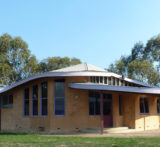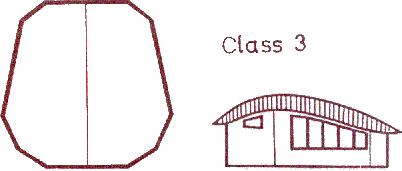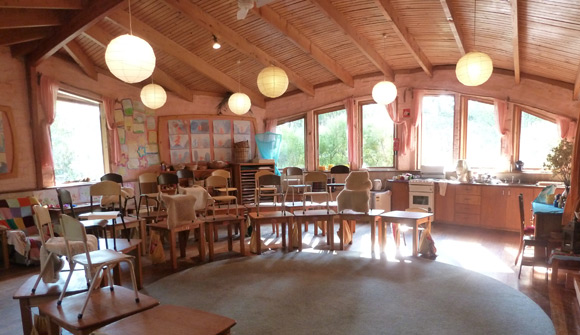
Class 1
In Class 1 the teacher stands before the children like the shepherd gathering his little flock. The floor plan encourages this relationship between teacher and class: the walls create a near circle to gather the children around the teacher. The ceiling is slightly higher than that of Class 2 and has a steeper curve. There is more headroom and a little more space to dream. The roof curves over the space with a nurturing and protective gesture and lifts up just a little over the windows to let in the light.
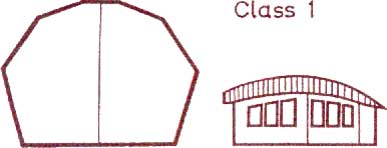
Class 1 Floor Plan and typical elevation
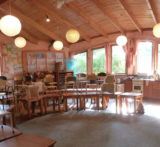
Class 1
Little Yarra Steiner School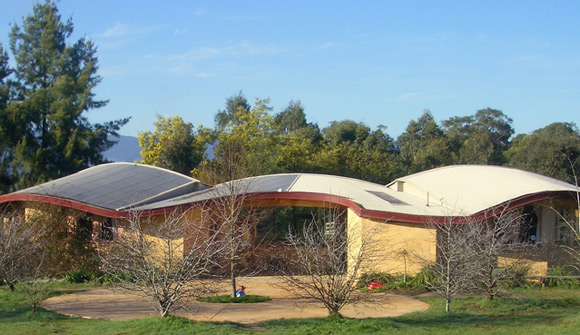
Class 2
By Class 2 the focus has started to shift more outward. Between tales of journeys and adventure there weaves an awareness of the landscape and a connection with nature forces and images of the 4 elements. The Class 2 room still allows the teacher to gather his little flock in a circle, but the circle is stretched out now, the flock is more 'jumpy' and a little harder to contain. The gesture of the roof is similar to that of Class 1 but the windows have become taller and the eave line lifts up further on three sides to allow more of the world into the room.
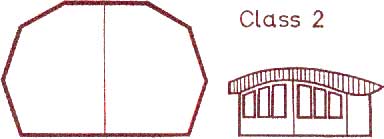
Class 2 Floorplan & Elevation
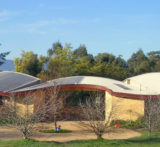
Class 2
Little Yarra Steiner School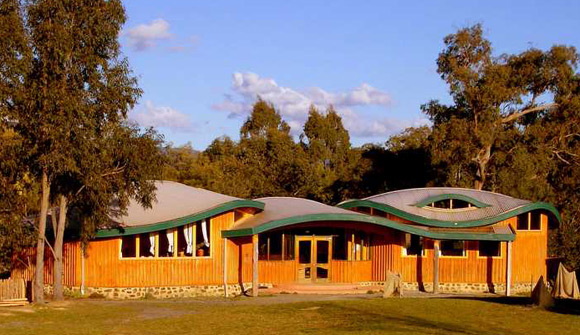
Class 3
The Class 3 room does not gather up the children in a circle any more. There is now a change in the relationship between teacher and class. The teacher’s authority becomes more important. The room is more elongated and divided into a wider front section where the teacher stands and a longer section for the Class. Both, through the floor plan and through the rise and fall in the roof, the teacher and the class are placed opposite each other. At the crossover, the space wherein the teacher and class meet, the room is at its highest point. At the front of the room the light streams from above; at the sides the walls have receded to make room for uninterrupted rows of windows which bring in lots of light and encourage the two way flow between the world outside and the class within.
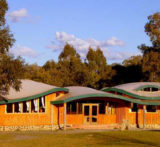
Class 3
Little Yarra Steiner School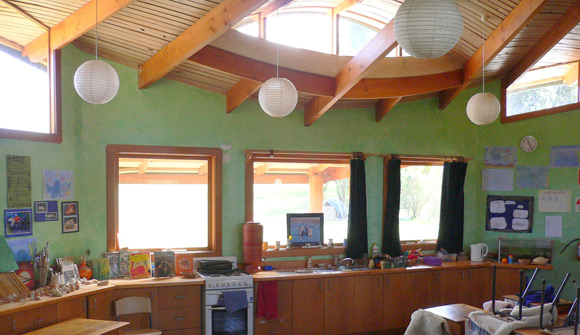
Class 4
Class 4 is a very social year. There is a sense of flow both socially and physically. Among all the primary class rooms the Class 4 room has the strongest sense of flow and rhythm. The roof weaves rhythmically up and down and particularly lifts over each comer, looking out into the 4 directions of the earth. The floor plans of classes 1 - 3 have a more rounded "organic" shape which pre determines the respective position of class and teacher. The class 4 floor plan, as a regular geometric form does not suggest where teacher and class are to be. Only after positioning the lower windows and blackboard do we know where the teacher will stand. As a result of this "front" and "back", "left" and "right" become less clearly defined which adds to the number of possibilities to position the class and creates a sense of movement and sociability in the space within. In addition to the lower windows, the class 4 room also has windows high up in the roof and under the eves. The gesture of these windows is one of looking out into the distance from a higher vantage point - just like the class 4 child also looks out to a widening landscape and a world that is getting increasingly bigger.
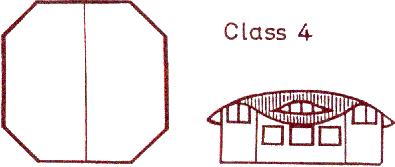
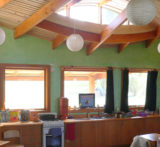
Class 4
Little Yarra Steiner School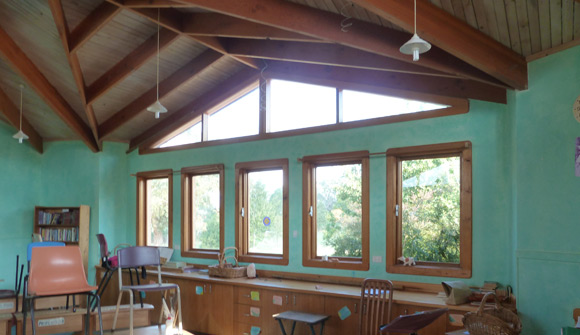
Class 5
Around class 5 the ability to form abstract concepts of the world begins to emerge. The class 5 room seeks to reflect a new enquiring outlook into the world. What was a small roof window arising out of the undulating flow of the class 4 roof has become a wide, formalized gable window in class 5, reminiscent of the angles and proportions found in Ancient Greek architecture, Ancient Greece being the cultural theme for class 5. Overall the room has much less of the organic flow evident in the earlier rooms, in favor of greater formality and weight. The greater degree of formality is connected with the intrinsic nature of conceptual thought, which brings structure, form and understanding in contrast to movement and flow which arise from the heart. In the class 5 child there is still a perfect balance between movement and form, but this balance is about to tilt in the following years.
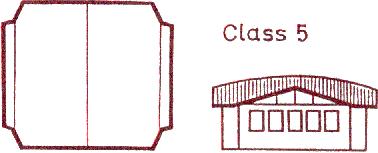

Class 5
Little Yarra Steiner School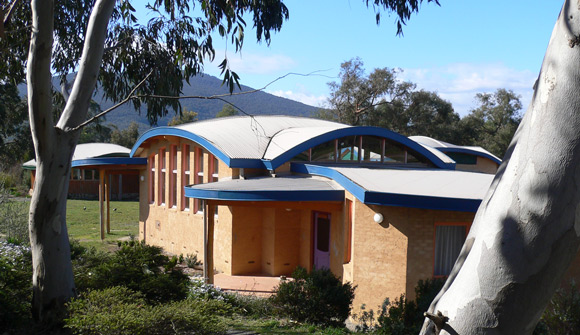
Class 6
The cultural yearly theme for class 6 is Ancient Rome. If the Greeks were Artists, Scientists and Philosophers, the Romans were Rulers, Law makers and Empire builders. What has been described above as the “descent from heaven to earth” could also be expressed geometrically as the journey from the circle (or sphere) to the square (or cube). In class 6, however, the square of the floor plan is balanced by the rounded quality of the roof, which assumes a dome like character. Similarly, the gables of class 5 have become arches in class 6, reminding us of the ancient Romans who first invented the technique to construct arches and domes in their buildings
-
.
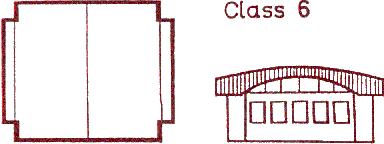
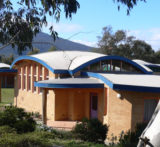
Class 6
Little Yarra Steiner School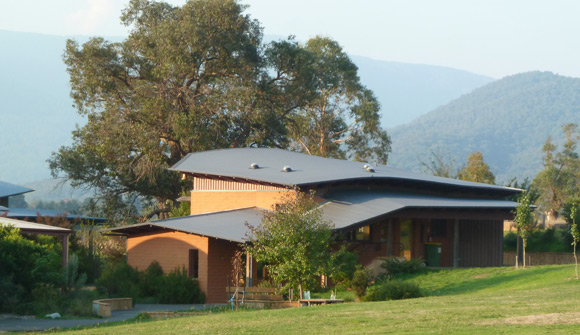
Upper School
What is the overall difference in architectural design and atmosphere between the lower and upper school and what are the unifying qualities? The lower school is characterized by the maturation of the etheric body and the development of the imagination. Constitutionally the lower school child lives in the rhythmic system. This calls for forms that that are more flowing, rhythmic, musical and symmetrical in character. In anthroposophical terminology we have a predominance of “sound ether forms” and the WATERY element. The upper school was designed in collaboration with Alvyn Willams, Soft Loud House Architect. It is characterized by the maturation of the astral body and the development of the faculties of thinking, analyzing, synthesizing and understanding. In the lower school we learn by doing, in the upper school we learn to understand what we already know. The faculty of imagination, which developed in the lower school, is now able to transform itself into a capacity for creative thought. This suggests that what is needed in the upper school are forms that create interest and curiosity and are able to stimulate, awaken and enliven the capacity for lateral thinking. This should not come at the expense of rhythm and warmth of soul, but in addition to it. It is the element of LIGHT which lives in the straight line and which forms interesting and lively angles and dynamically balanced symmetries that stimulates our thought and awakens interest and alertness of mind. The anthroposophical term for this quality and force is “light ether”. In practice this means that roof lines are sharper and less curved, fascias are not round but segmented and there is a higher degree of complexity and less symmetry in the angles of floor plans and spaces created between buildings. The whole question of symmetry is further explored in the following.
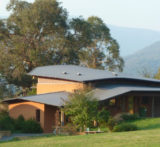
Upper School
Little Yarra Steiner School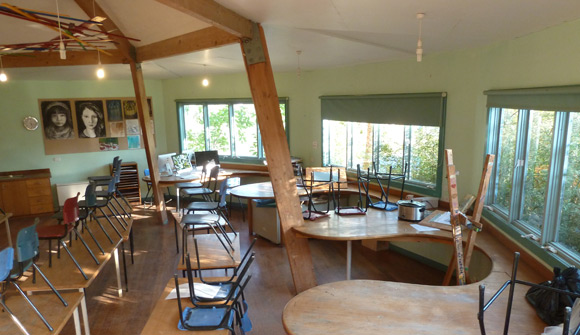
Science Labs
This posed a new design challenge. Whilst the practical function of a Biology and Chemistry Lab and Class Room was clear enough, what wasn’t obvious was the spiritual identity or purpose for a science building. Without a deeper purpose we are left with practical functionality alone, which can be resolved quite easily through good design, but the results would be utilitarian with little inspirational power or value.
In the case of the previous buildings it was straight forward. It is easy to see the link between a Library / Administration building and the qualities of ‘Thinking’ and ‘Sense Perception’. It is also easy to relate the changing qualities of the lower school class rooms to the changing states of consciousness in the child. But what might be the appropriate essence to incorporate into a Science Lab? It couldn’t be the consciousness of the students since the rooms were being used by many age groups. For a while qualities such as ‘interest and curiosity or observation’ seemed to suggest themselves until, in conversation with a colleague, the idea of ‘Life forces’ came up. This instantly made sense. In the sister document (TMP&A) attached to the Master Plan and referred to several times above, there is a separate chapter about Life forces or the so called ‘etheric body’. To quote a passage from there: “It is a tragedy that main stream materialistic science has been unable or unwilling to establish the reality of etheric forces. Etheric forces keep the body alive and whole. Physical Forces cause it to fall apart, rot and decay. Considering the nature of physical forces, there is little wonder about the effects produced by a science and technology that is exclusively based on these forces. However, there is much research in this field happening to day all over the world and in many branches of science, although not within conventional main stream science. But then genuinely new developments and discoveries rarely originate within conventional thought, which is easily threatened and routinely resists them until the momentum swings the other way.” In other words, if the qualities of the ‘Etheric Forces or Life Forces’ could be made to be the inspiring idea for a science building the spaces created might contribute to provide the inspiration for a future science that is supportive of life and in harmony with the natural world. Once the overall ‘essence or purpose’ had been found, the actual design process could start.
The idea was to treat each Lab slightly differently. The Chemistry Lab has its strongest connection to “Sound Ether” which is also referred to as “Chemical Ether”. The Biology Lab, in dealing with ‘life’ as the name implies, would focus more on ‘Life ether’ and the totality of all four ethers together, which characterize every living creature.
The overall gesture of both Science Labs is the upward thrust of the domed roofs, breaking through the lower roof sections like the new bud breaks through the bark of the tree. This upward movement carries within it the quality of levity and lightness, without which the sap couldn’t rise in the tree and living creatures could not move and defy gravity.
The space inside the Biology Lab is whole and undivided while in the Chemistry Lab the walls expand and contract in a rhythm as if to divide the room into separate cells. The work benches in both rooms are crafted out of thick timber and are shaped in a meandering form out of which the various work stations emerge.
Chemistry Lab Interior
In the Chemistry room the work stations are fewer and larger and continue the image of cell division suggested through the contracting walls. In the Biology Lab the workstations are more numerous and form smaller intervals in line with the stronger internal force and the dominance of the whole over its parts.
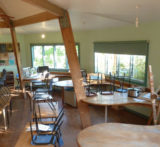
Science Labs
Little Yarra Steiner School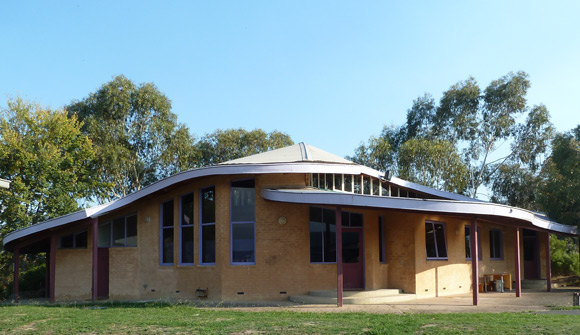
Library & Adminstration
As administrative center the Library/Administration Building serves as the ‘eyes, ears, and voice’ of the school. It is the first point of contact for visitors to the school. It is the communication link between different parts of the school and it also is the spot where external services such as electricity, phone, and gas come in before spreading out to the other parts of the school. In this role the building’s function is like that of a ‘head’, which is the part in an organism where most of the sense organs are located. Like a head, the Building has a clearly defined back, where the roof is lowered, and a face with a high roof and tall windows opening into an entry lobby that greets the visitor and looks out on to the central entrance road that comes into the property.
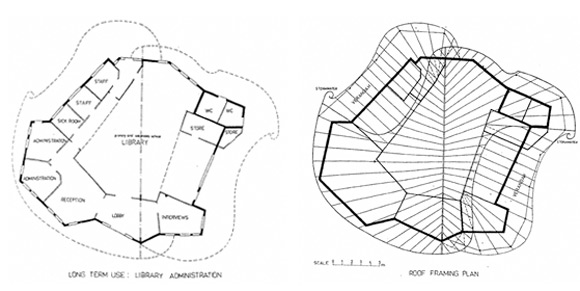
The analogy that compares the administrative sphere to a ‘head function’ is also appropriate in regard to the building’s second purpose, that of the School’s Library.
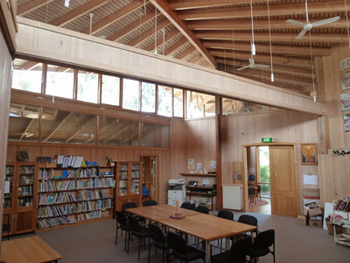 We think in our heads. Thinking as an activity is what ideally a library building might wish to support and encourage. Thinking, however, has many a shape or form, from being ‘hard’, ‘rigid’ or ‘calculating’ on one end of the scale to flightful fancy or illusion on the other extreme. The inspiring motive for the Library/Administration building was to create a space where thought might be fluid, creative and lateral and where the cool logic of the head is warmed by forces from the heart. To this end, the floor plan of the building is many sided, the angles complex and unpredictable, ceiling heights are varied, the structural skeleton a feature of the building and the symmetry dynamic. All such elements have the intent of supporting a lively interest and alert wakefulness. The curves of the roof introduce gentleness, warmth and movement. The rise and fall of the eve lines mirror the movement of a lemniscate, the right and left halves of the roof are placed into a dynamic symmetry, hovering like outstretched wings over the building, barely touching and leaving the impression of a bird in flight.
We think in our heads. Thinking as an activity is what ideally a library building might wish to support and encourage. Thinking, however, has many a shape or form, from being ‘hard’, ‘rigid’ or ‘calculating’ on one end of the scale to flightful fancy or illusion on the other extreme. The inspiring motive for the Library/Administration building was to create a space where thought might be fluid, creative and lateral and where the cool logic of the head is warmed by forces from the heart. To this end, the floor plan of the building is many sided, the angles complex and unpredictable, ceiling heights are varied, the structural skeleton a feature of the building and the symmetry dynamic. All such elements have the intent of supporting a lively interest and alert wakefulness. The curves of the roof introduce gentleness, warmth and movement. The rise and fall of the eve lines mirror the movement of a lemniscate, the right and left halves of the roof are placed into a dynamic symmetry, hovering like outstretched wings over the building, barely touching and leaving the impression of a bird in flight.
